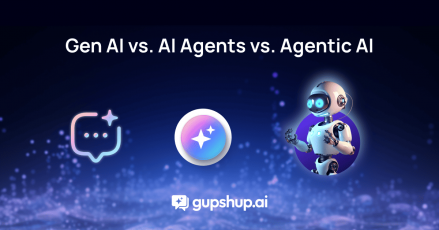What is Conversational AI? The 2024 Guide!

What is conversational AI? How does a conversational AI platform work? What are the most common conversational AI use cases?
In this blog, we will address all these questions.
Let’s start with – What is Conversational AI?
Today’s customers expect fast answers and instant gratification. They want digital support and personalised experiences from the brands they support. They also want to be “heard”, and treated as unique individuals, not as faceless “cases” or “tickets”.
In such a scenario, modern companies must deliver omnichannel, personalised and real-time Customer Experiences (CX) – for which old-fashioned customer communications tools are ineffective.
Enter – Conversational AI.
Conversational AI refers to technology that allows machines to understand and process human language inputs, and respond to them in a near-human manner with the right context and smooth flow.
What is a Conversational AI platform?
A Conversational AI platform enables organisations to build user-friendly applications like chatbots and voice assistants that allow customers to interact with the brand in a simple, real-time manner. It also helps the brand connect with customers at scale, and deliver personalised engagement and support.
Conversational AI applications enable seamless and automated communications between brands and customers. For this to happen, they use large volumes of data, as well as Machine Learning (ML) algorithms and Natural Language Processing (NLP) capabilities. This combination allows these tools to:
- Recognise speech and text inputs from human users
- Decipher language syntax, nuances and context
- Understand user intent
- Translate their meanings
- Imitate human interactions to answer queries, address concerns and resolve issues
Often, such tools can do all of the above in multiple languages. The extent to which these capabilities are used depends on the type, function and purpose of the conversational AI tool being deployed.
Of course, Conversational AI cannot completely replace human-to-human interactions. However, it does allow companies to help their audience in many ways, even with limited resources. It also enables them to automate many mundane, repetitive or low-value tasks, so they can serve customers without adding expensive resources to the process.
In addition, automation with Conversational AI improves the productivity of human agents, and enables them to focus on more high-value and meaningful tasks. By effectively combining Conversational AI with human support, organisations can quickly connect more people to the support they need and thus redefine customer experiences.
User: What’s the weather prediction for this weekend in Bombay? Chatbot: I don’t know what you mean. Please simplify the question. User: What’s the weather going to be like this weekend in Bombay? Chatbot: Are you on a boat? I cannot find the information you need. User: No, I’m not on a boat. I just want to know the weather for this weekend in Bombay. Chatbot: Ah, the weather. I can help you with that. .......no action for 3 minutes. User: Well? Chatbot: Sorry, I dozed off there for a bit. User: The weather this weekend? In Bombay? Chatbot: Do you mean Bombay Hills in Auckland, New Zealand? User: No! I mean Bombay, India. Chatbot: Sorry, I’m not aware of any such city. User (now frustrated and “shouting”): Damn you! WHAT’S THE WEATHER GOING TO BE LIKE THIS WEEKEND IN MUMBAI, INDIA? Chatbot: The weather in Mumbai, India is 34ºC, clear and sunny, with 8% probability of rain showers. User: This weekend? Chatbot: I don’t have that information. Have a nice day! User: ARRRGH!!
The above (imaginary) conversation is everything that conversational AI and conversational AI chatbots are not.
Types of Conversational AI
Chatbots are among the most popular applications of Conversational AI. Thus, it’s not a question of Conversational AI vs Chatbot. Rather, chatbots are based on Conversational AI technology.
A conversational AI chatbot enables companies to automate some part of their customer communications setup for marketing, promotions, support, and many other use cases. It can be implemented on the company’s website or on other channels like Facebook Messenger, WhatsApp, Slack, etc.
The easiest and fastest way to design and deploy a chatbot is with a low-code bot-builder platform like Gupshup. This user-friendly conversational AI platform provides numerous bot-builder tools, pre-built templates and conversation flow designers so even non-technical users can deploy chatbots in just a few hours, rather than several days or weeks. It also supports developers with many development tools, a cloud-based Integrated Development Environment (IDE) and a Conversational AI API (REST) for NLP.
Apart from chatbots, organisations can leverage the power of Conversational AI platforms to create many other kinds of applications. Here are some popular Conversational AI examples:
Mobile Assistants
Two of the most well-known mobile assistants are Google Now and iPhone Siri. Users use them to perform certain functions quickly, either because their hands are full (e.g. while driving), or because they want to avoid the hassle of typing. These include sending text messages, asking for weather updates, and asking for the results of a search query.
Voice Assistants
These voice-enabled devices support users with non-transactional queries such as playing music, setting alarms, providing weather reports or sports updates, creating shopping lists, making phone calls, sending text messages, etc. Google Home and Amazon Alexa are great examples.
Interactive Voice Response (IVR) Systems
IVR systems are already a staple in many contact centres, allowing companies to implement service automation, and reduce overall customer service costs. Now, with Conversational AI IVR – powered by Natural Language Understanding and Machine Learning – callers can control the conversation, so it flows more naturally to an appropriate conclusion. The system can also capture and analyse exact phrases and sentences, and use this information to understand customers, improve support offerings, and enhance user experiences.
With Conversational AI, companies can build any kind of interactive messaging-enabled interface. These applications allow users to:
- Ask questions
- Get recommendations
- Execute transactions with self-service
- Get support for an issue,
and thus achieve any kind of context-dependent goal through a seamless, human-like conversation.
Conversational AI Use Cases and Industry Applications
Many Conversational AI platforms like Gupshup are so versatile that they can be adapted for use in any industry, and for a wide range of use cases and business functions.
These include:
Banking and Finance
With Conversational AI applications, banks and other financial services providers can make it easy for their customers to:
- Keep track of their finances (e.g. salary credits)
- Send and receive money
- Receive reminders on bill payments
- Apply for loans or mortgages
- Access high-quality, timely and relevant support
Insurance
By effectively leveraging Conversational AI, insurance firms can redirect customers to online channels to reduce friction and increase claim processing speeds. They can also deliver highly personalised support that improves the customer’s trust in the service, and enhances their brand experience.
Retail and eCommerce
The Conversational AI market for retail and eCommerce is growing. In fact, by 2023, chatbots will account for $112 billion in retail sales. This is because such solutions enable retailers to deliver personalised, low-friction shopping advice, recommendations, communication and experiences. By enhancing the shopper’s journey, they can boost their conversations, revenues and profits.
Restaurants and Food Service
Some food brands are experimenting with voice-based ordering and other types of Conversational AI solutions to enhance diners’ experiences. Gupshup’s restaurant chatbot is a versatile application that enables restaurants to manage several aspects of their business on auto-pilot, from order-taking and contactless dining to billing and payments.
They can simplify the service process for both dine-in and take-away customers, increase repeat business, manage inventory, offer special or limited-time promotions, and do a lot more to grow their business. Gupshup is one of the very few companies offering such a cutting-edge chatbot in India, making it one of the best Conversational AI companies in India.
Travel and Hospitality
About 85% of travel companies already use Conversational AI technology in some form. Chatbots and other applications make it easy to deliver the right answers and information to customers on the device they feel most comfortable with. They can also help users with many other tasks, such as flight, cab or hotel bookings, checkouts, upgrades, postponements and billing.
In addition to these five sectors, Conversational AI use cases include:
- Government
- Education
- Telecom
- Automotive
- Internet of Things (IoT)
- Energy and Utilities
- Media and Entertainment
How does Conversational AI Work?
In simplest terms, Conversational AI translates language so a machine (e.g. a chatbot or voice assistant) can understand users and respond to them in a smooth, human-like manner. To do this, it relies on a process pipeline consisting of three stages:
- Automatic Speech Recognition (ASR)
- Natural Language Processing (NLP) or Natural Language Understanding (NLU)
- Text-to-Speech (TTS) with voice synthesis
The customer requests the system either via text or voice. ASR technology recognises the request, and unpacks the language and context behind it. Then NLP cleans up the request so it can be understood by the NLU and responded to by TTS and voice synthesis. The system’s underlying ML algorithms learn from the data collected over time to improve the accuracy, performance and response quality of the Conversational AI system.
NLP and ML are particularly important in the system. NLP helps analyse the user’s request and takes it towards a logical conclusion. ML training models enable the system to constantly learn and improve, even without explicit human programming.
Conclusion
According to an MIT survey, 90% of businesses reported measurable improvements in complaint resolution speeds with Conversational AI chatbots. Considering that the Conversational AI market is expected to grow to $13.9 billion by 2025, it’s clear that many organisations have already recognised its value and potential.
If you’re looking to add Conversational AI capabilities to your organisation’s communications stack, contact Gupshup. Our no-code platforms can help you quickly deploy fully-customised chatbots and virtual agents for numerous use cases. To know more, explore our website.




